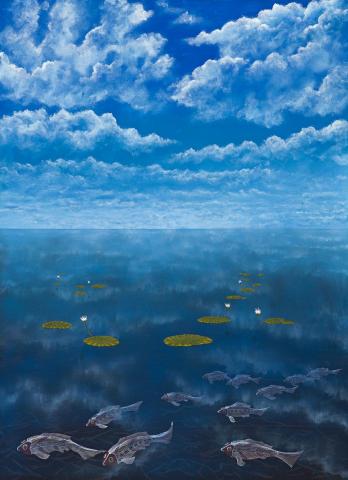GUYI GA GINIMBIRRI (FISH AND CLOUDS), 1992
LIN ONUS
synthetic polymer paint on canvas
167.5 x 121.5 cm
signed lower right: Lin Onus
inscribed on label verso: "GUYI GA GINIMBIRRI" / (FISH AND CLOUDS) / SIZE: 167 x 122 c.m. / ACRYLIC ON LINEN / 1992
Estate of the artist, Melbourne
Savill Galleries, Melbourne (label attached verso)
Private collection, Melbourne
Lin Onus, Savill Galleries, Melbourne, 30 October - 23 November 2003, cat. 1
Lin Onus, Savill Galleries, Melbourne, 2003, cat. 1 (illus. front cover and p.1)
Described as 'a self-confessed cultural mechanic'1, Lin Onus remains acclaimed today for his dedication to reconciling cultures through his roles as artist, educator, activist and administrator. Of Yorta Yorta and Scottish descent, he began painting during the 1970s, coinciding with both the acknowledgment of Aboriginal art in Australia and the emergence of the political debate on issues of native title and equal opportunity. Straddling such dualistic perspectives - one Western and representational, the other Aboriginal and spiritual - Onus was thus able to explore fresh ideas from a diverse range of influences, subverting Western perceptions of indigenous art with subtlety and sophistication. Indeed, occupying what anthropologist Levi Strauss defines as that 'in-between' space between multiple worlds, Onus was afforded the rare opportunity 'to glimpse through many slightly ajar doors' - paradoxically belonging everywhere, and nowhere. As Margo Neale elaborates in the catalogue accompanying the artist's retrospective at Queensland Art Gallery in 2000, '... his works are like the tales of a roving storyteller or mythmaker'. 2
Of particular relevance to his 'water and reflection' paintings such as the monumental Guyi Ga Ginimbirri (Fish And Clouds), 1992 featured here, were Onus's regular spiritual pilgrimages to Arnhem Land which, he later mused, gave him 'back all the stuff that colonialism had taken away'.3 As Neale observes, '... now, in addition to his own ancestral site at Barmah forest he was permitted to access new sites of significance such as Arafura Swamp, or his adoptive community at the outstation Garmedi; to kinship systems in which he and his family were assigned skin names; to language that he used for many of the titles of his works; to ceremony and Dreaming stories'.4 Arguably, most influential upon his stylistic evolution, however, was the relationship he developed in Arnhem Land with the highly esteemed Aboriginal painter, Jack Wunuwun. Inspired by the older artist's bark painting techniques such as rarrk (cross-hatched designs), Onus subsequently embarked upon his celebrated series of watery landscapes which, rich in reflections and ambiguities, substituted the traditional European panoramic view for one described by his mentor Wunuwun as 'seeing below the surface'.
Both mesmerisingly beautiful and multifaceted in its meaning, Guyi Ga Ginimbirri (Fish And Clouds) illustrates well Onus's desire to create an art that could be appreciated on numerous levels by everyone, not just an elite few. As Neale suggests, elucidating the deeper significance of such works, '... they are deceptively picturesque, for things are not always what they seem. Laden with crosscultural references, visual deceits, totemic relationships and a sense of displacement, they, amongst other things, challenge one's viewing position: Are you looking up through water towards the sky, down into a waterhole from above, across the surface only or all three positions simultaneously?'5
1. Neale, M., Lin Onus, Savill Galleries, Melbourne, exhibition catalogue, 2003, p. 1
2. Neale, M., Urban Dingo: The Art of Lin Onus 1948-1996, Queensland Art Gallery, Brisbane, 2000, p. 18
3. Onus, cited ibid. p. 15
4. ibid. pp. 15-16
5. Neale, op.cit., 2003, p. 1
VERONICA ANGELATOS
